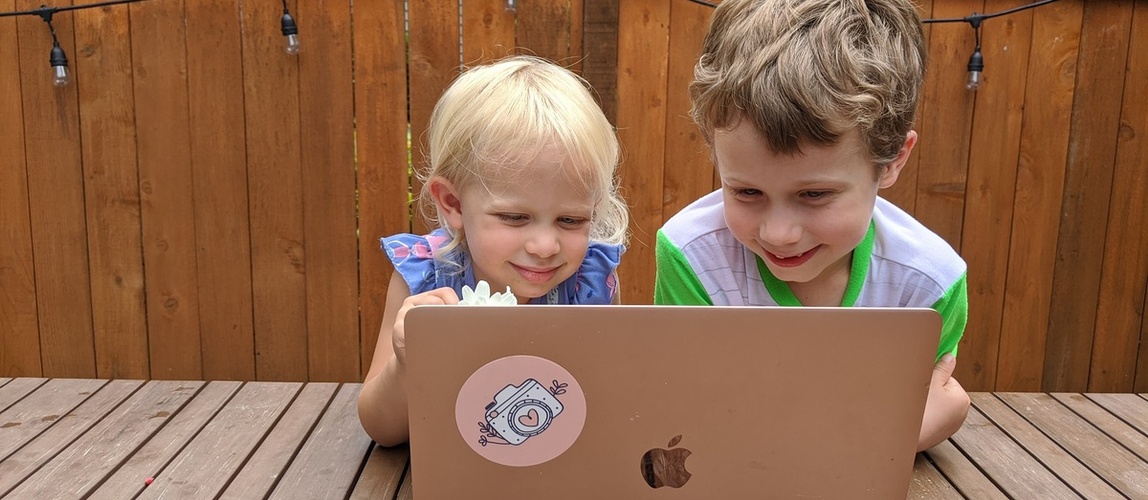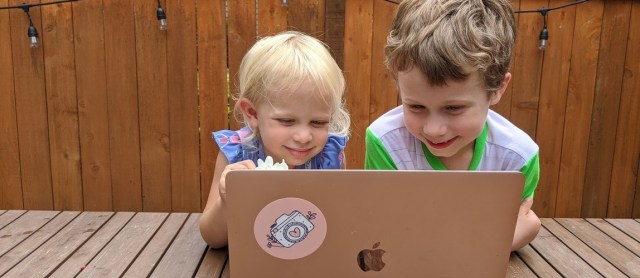
Screens are an undeniable part of our world: Screens have enabled me to meet, learn from, connect with and genuinely befriend people in ways that have changed my life. Tinkergarten—this beautiful, natural human experience would never be happening for families without the clever use of screens.
Now that COVID happened, it’s no longer an option to wing it with screens. Trying to search for the one, definitive “right” way to manage screens has proven exhausting to me and confusing to my kids. At the end of the day, we each need to find the balance with screens that work for our family. Below we’ve pulled together next-level insights that we hope prove helpful as you face the next round of learning in quarantine and help you and your children develop a relationship with screens that works for you!
Avoid Mixed Messages
Show kids that, when they are on screens, you feel good about them being there. Kids pick up on our feelings and take on our screen discomfort as their own or start to see screens as a “forbidden fruit,” giving screens even more power. So, when you’re giving the OK for screens, give it whole-heartedly.
Look for Quality
Look for who is creating it and why. If an organization values or has on its team educators or child development experts, chances are they are designing media to engage kids and help them learn. Look for who they partner with, too—organizations that are truly committed to improving kids’ learning tend to align with others who are as well. We can recommend Khan Academy Kids and organizations included in Common Sense Media’s Wide Open School project as examples of truly educational, engaging screen time.
Seek Interactive Screen Experiences
Nearly everyone enjoys a little passive screen time, but when it comes to kids and screens, the more interactive and active their brains and bodies are during the experience, the better. If you’ve tried online classes with young kids, you’ve seen this for yourself. Online sessions that include music, movement, and the chance to interact, ideally with a live and dynamic person, better engage and educate kids, especially young kids. That’s why we’ve designed our Tinkergarten Online Circle Time classes with these elements in mind and why, as parents, we screen for these features every time.
Set Reasonable Time Limits
Start by making sure that kids learn that there is a start and an end to a screen session. Before kids begin, you can establish with them how long it will be and try to make the units of time something kids can understand. For kids ages two to five, an hour is, generally, the suggested dose of screen time for the day, so try to time that hour well and balance it with other experiences.
Help Young Kids Transition
We’ve all seen kids meltdown or even tantrum when it’s time to shut off a screen—and it’s not their fault. Screens do a number on our minds. Considering that, it’s a huge ask for a child to get off a screen and move to something new. Here some great ways to help kids transition.
- Stay as calm and soothing as you can, like you’d approach them when you need to wake them from a sleep.
- If you can, sit alongside them and join a minute or two before the screen has to come off, so you are already part of their world, making the transition less jarring.
- Give them a ritual like saying “goodbye” to the screen or putting the device somewhere special to “rest.”
- Try to schedule something offline that kids love right after screen time, whether it’s outside time, a particular toy, or even snack time.
Look for Balance
It may not be practical for you to track the minutes, but do try to stay consistent with how you approach screen time. When you flip flop or change the rules, kids get confused and rules start to lose their “oomph” altogether. Need an alternative to tracking time? Simply focus on building balance into your child’s overall schedule. Make sure that they take breaks, and that those breaks deliver what kids need most and what no screen can offer—time to be outdoors, to move and to use many different senses.
Slow down on the Senses
Children need to not only strengthen each of their senses; they also need to learn to use them in concert with one another. And, there are senses beyond the 5 we learn about in kindergarten that have a tremendous impact on how kids feel, behave, and are able to learn. Using screens narrows kids’ sensory experience to sight and sound alone—so, it’s imperative that you build in chances to use all senses. How best to do that? Play outdoors!
Keep Screens in Sight
Right from the start, we’ve encouraged our kids to be in shared spaces when they use their screens. It’s required us to invest in good headphones for all five of us, but it’s cut down almost entirely on the “sneaky screen time” behavior. And, more than once, one of the kids has mis-clicked, and we’ve been nearby to help them navigate new situations online—lessons you really need to be there to teach to keep kids safe.
Co-view & Co-play
When you can, join your children for part of a screen session. Talk with them about what you are seeing or ask questions after the session to help kids process what they experienced. If you are not able to co-view during the day, set up a regular screen time ritual as a family, like Friday movie night so you can experience screens together and start to teach kids how to think about stories, characters, and who is telling the story.
No-screen Zones
Designating “no-screen” times and spaces—whether it’s dinner time, weekends or when family or friends are visiting—can help everyone, adults included, reset and keep a healthy relationship with screens. This old fashioned, screen-free kind of togetherness just can’t be beat, so schedule as much no-screen time as you need to unplug and really connect!











